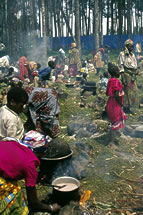DRC: Mapping human rights violations 1993-2003
 In the wake of the discovery of three mass graves in the eastern part of the Democratic Republic of the Congo (DRC) in late 2005, the United Nations first announced its intention to send a human rights team to conduct a mapping exercise in DRC in a June 2006 report to the Security Council.
In the wake of the discovery of three mass graves in the eastern part of the Democratic Republic of the Congo (DRC) in late 2005, the United Nations first announced its intention to send a human rights team to conduct a mapping exercise in DRC in a June 2006 report to the Security Council.
In May 2007, the UN Secretary-General approved the terms of reference of the mapping exercise following a series of consultations among relevant UN agencies and partners and with the Congolese government
The mapping exercise, led by the Office of the UN High Commissioner for Human Rights (OHCHR) had three objectives:
- Conduct a mapping exercise of the most serious violations of human rights and international humanitarian law committed within the territory of the DRC between March 1993 and June 2003.
- Assess the existing capacities within the national justice system to deal appropriately with such human rights violations that may be uncovered.
- Formulate a series of options aimed at assisting the Government of the DRC in identifying appropriate transitional justice mechanisms to deal with the legacy of these violations, in terms of truth, justice, reparation and reform, taking into account ongoing efforts by the DRC authorities, as well as the support of the international community.
The mapping exercise began in July 2008. Between October 2008 and May 2009, a total of 33 staff worked on the project in the DRC (including Congolese and international human rights experts). Of these, some 20 human rights officers were deployed across the country, operating out of five field offices, to gather documents and information from witnesses to meet the three objectives defined in the terms of reference. The report was submitted to the High Commissioner for Human Rights in June 2009 for review, comments and finalisation.
The mapping team's 550-page report contains descriptions of 617 alleged violent incidents occurring in the DRC between March 1993 and June 2003. Each of these incidents points to the possible commission of gross violations of human rights and/or international humanitarian law. Each of the incidents listed is backed up by at least two independent sources identified in the report. As serious as they may be, uncorroborated incidents claimed by one single source are not included. Over 1,500 documents relating to human rights violations committed during this period were gathered and analysed with a view to establishing an initial chronology by region of the main violent incidents reported. Only incidents meeting a 'gravity threshold' set out in the methodology were considered. Field mapping teams met with over 1,280 witnesses to corroborate or invalidate the violations listed in the chronology. Information was also collected on previously undocumented crimes.The Report*
Comments by States*
News Release*
Information Notes*
- Mapping exercise
English | French - Crimes
English | French - Sexual violence
English | French - Children
English | French - Natural resources
English | French - Neighbouring states
English | French - Impunity
English | French - Transitional justice
English | French
Video interview with the High Commissioner
Written Statement by the High Commissioner*
* these documents are in PDF format